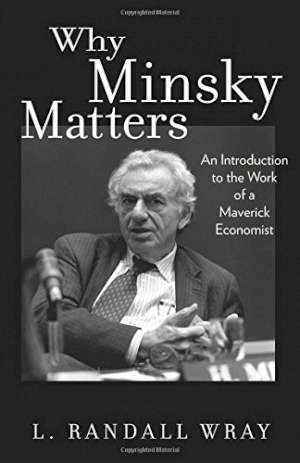28 June 2016
Why Minsky Matters
An Introduction to the Work of a Maverick Economist
L Randall Wray
2015, Princeton University Press, 288 pages,
ISBN 9780691159126
Reviewer: Ian Harwood, Independent Consultant

Ever since the Global Financial Crisis struck and wrought its carnage, the concept of a ‘Minsky moment’ – which describes the tipping-point at which a euphoric and highly-leveraged financial boom is transformed into a painful bust – has become widely understood by economists and those who work in financial markets.
The ideas of the phrase’s namesake, the economist Hyman Minsky, have also become much better known than was the case prior to the Crisis, not least because a clutch of Minsky’s key works – John Maynard Keynes (1975), Can “It” Happen Again?(1982), and “Stabilising an Unstable Economy” (1986) – have been re-published since (just as have previous classics of the financial crisis genre, such as J.K. Galbraith’s 1929). Importantly, what Minsky had to say about the way banks, financial markets and economic activity interacted – notably his fundamental and contrarian insight that ‘stability is destabilising’ – has begun to be taught in undergraduate Economics courses (though, unfortunately, so far to an extent far less than deserved).
The reason for this elevation from relative academic obscurity is crystal-clear: Minsky’s ‘financial instability hypothesis’ explained very clearly the driving forces behind the extraordinary US housing and credit boom which eventually came to grief and resulted in the 2007/09 meltdown. And with the key tenets of pre-crisis conventional wisdom – pervasive rational markets; the sheer impossibility of speculative bubbles; the abolition of boom and bust as long as inflation remained under control (aka the Great Moderation) – so gravely undermined by the traumatic turn of events, Minsky’s thinking was amongst that best-suited to fill the vacated intellectual space.
While Minsky is best known for his thesis that market economies are inherently unstable, with an in-built propensity towards boom and bust, he wrestled throughout his career with the question of whether “It” – “It” being the 1929-33 Great Depression – could happen again. Growing up under the shadow of this cataclysmic event, it is perhaps unsurprising that, like so many of his contemporaries, he was always looking apprehensively over his shoulder for fear that a Mark 2 version would emerge. Intriguingly, Minsky concluded that a repetition was unlikely for the simple reason that government was much bigger in the post-war period and that the Fed, having learnt a bitter lesson from its mistakes committed in the early 1930s, would henceforth act as an unreserved lender of last resort. In this judgement Minsky was wholly justified. Ironically, though, the Fed’s desire to underpin markets and the economy – which began long ago and reached its apogee with the ‘Greenspan put’ – very substantially contributed to the events leading up to the Great Depression Mark 2 near-miss of 2007/09.
All this is excellent reason to welcome the publication of L. Randall Wray’s Why Minsky Matters. Wray is well-positioned by virtue of his experience to explain Minsky’s thinking: he was Minsky’s teaching assistant and subsequently a colleague at the Levy Institute, a well-established hotbed of maverick, non-mainstream economists.
Wray is also a fervent advocate of Minsky’s ideas, whose self-declared motivation for writing this book was: “To make Minsky’s ideas accessible to a wider audience.” Such a purpose is especially helpful as Minsky’s analysis ranged widely, while his style was opaque and his ideas difficult fully to grasp. I’m pleased to be able to say, therefore, that Wray succeeds admirably in his endeavour: his is a book well worth reading by those unfamiliar with Minsky’s thought and who wish to rectify the situation.
I must confess, though, to being puzzled by the absence of Wray making any reference whatsoever to the late Charles Kindleberger who in his superlative investment classic Manias, Panics and Crashes, the first edition of which was published in 1978, explicitly adapts Minsky’s credit cycle stages model – displacement; euphoria; over-trading; financial distress; revulsion – to deploy in his comprehensive analysis of past financial crises. Kindleberger certainly deserves credit for popularising Minsky’s financial instability hypothesis’ – and, moreover, fully grounding it in evidence – decades before the Global Financial Crisis.
